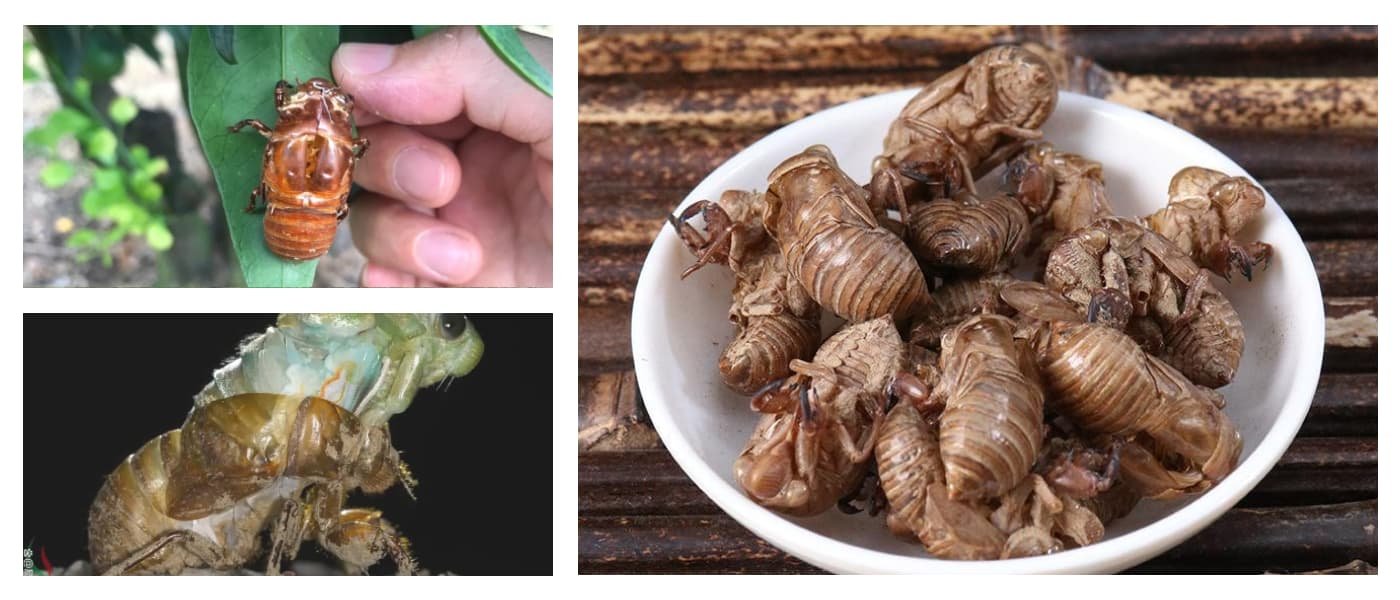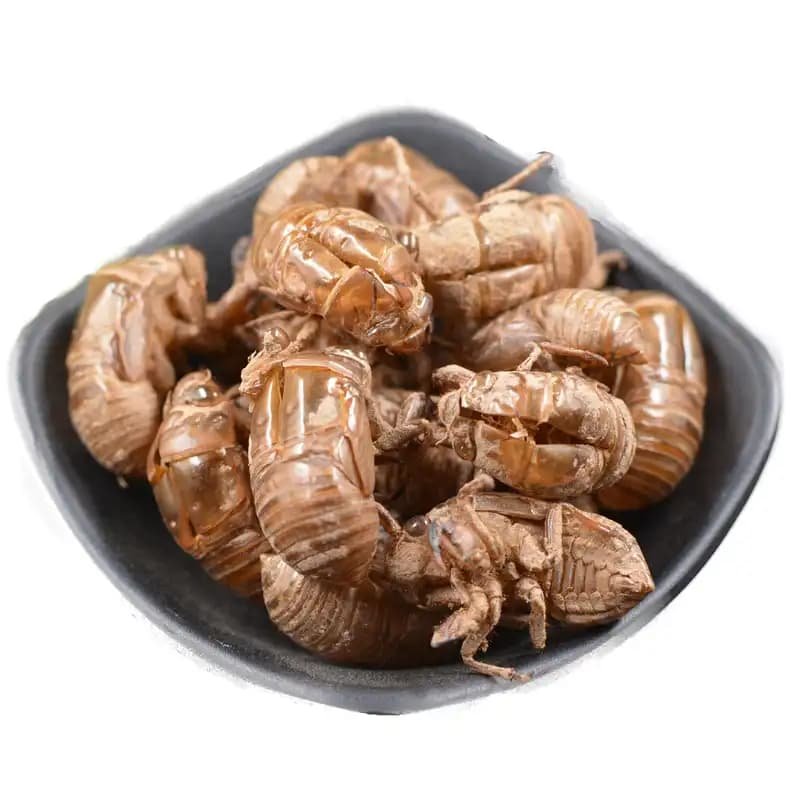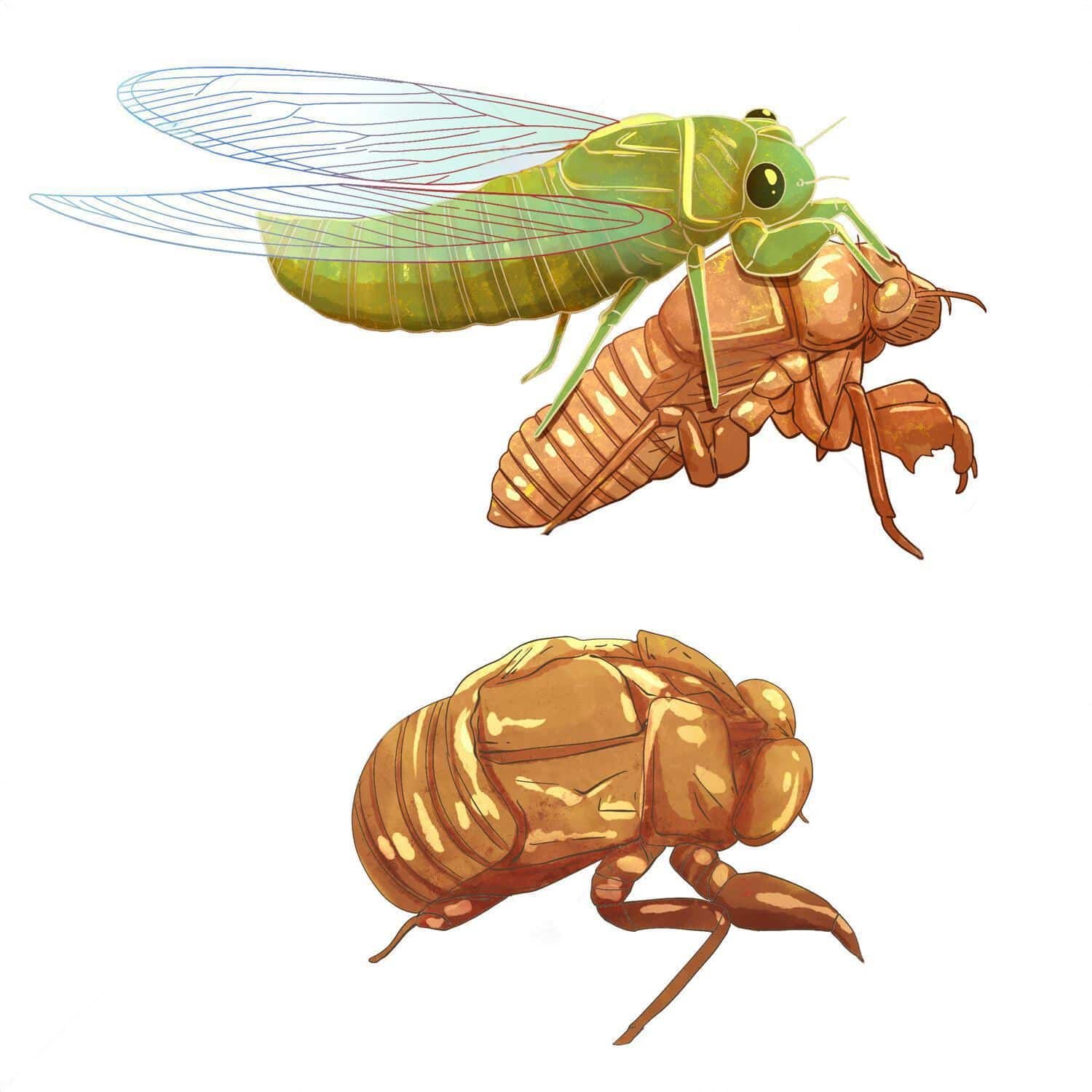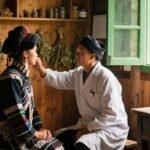Cicada Molting(Chan Tui,Cicada Slough,Cicada Shell,Cicada Exuviae)

What Is Cicada Molting (Chan Tui)?
Cicada Molting (Chan Tui) is a traditional Chinese medicinal material derived from the exuviae (shed skins) of the nymphs of Cryptotympana pustulata Fabricius, an insect belonging to the Cicadidae family.
Nature and Flavor: sweet and salty in flavor, cool in nature.
Meridian Affiliation: Lung and Liver meridians.
It is known for its traditional functions of dispersing wind-heat, soothing the throat and improving the voice, promoting eruption of rashes, improving vision, clearing nebula (superficial eye opacity), and calming internal wind to relieve spasms and convulsions.
It is commonly used to treat wind-heat type common cold, the early stages of febrile diseases, sore throat, hoarseness, measles that fail to erupt, pruritic rashes, red eyes with visual obstruction, infantile convulsions (both acute and chronic), and tetanus.
What Are the Benefits of Cicada Molting (Chan Tui)?
Traditional Functions
- Disperses wind-heat
- Soothes throat and improves voice
- Promotes rash eruption
- Clears the eyes and reduces nebula
- Calms wind and relieves convulsions
It is traditionally used for wind-heat common cold, early febrile diseases, sore throat, hoarseness, measles that don’t fully erupt, itchy rashes, red eyes with clouded vision, various forms of infantile convulsions, and tetanus.
Modern Pharmacological Effects
1. Anticonvulsant Effect
Aqueous extracts of Cicada Molting (Chan Tui) have been shown to reduce convulsion-induced death rates in mice caused by strychnine. Alcohol extracts also help delay death from tetanus toxin-induced convulsions in mice, though they are not effective against convulsions caused by pentylenetetrazole.
2. Analgesic Effect
Subcutaneous injection of the aqueous extract in mice, tested using the writhing method, has demonstrated significant pain-relieving effects.
3. Sedative Effect
Intraperitoneal injection of the aqueous extract in mice showed a clear sedative effect and enhanced the hypnotic effect of pentobarbital sodium. Alcohol extracts also exhibit significant sedative properties and can act synergistically with barbiturates.
4. Antitumor Effect
In vivo studies of water extracts indicate strong antitumor activity against Ehrlich ascites carcinoma cells. The active antitumor components were identified as macromolecular compounds.
5. Immunosuppressive Effect
Extracts significantly reduced the weight of immune organs such as the thymus and spleen. Using the chicken red blood cell assay, it was found to suppress the phagocytic activity of peritoneal macrophages.
6. Anti-Allergic Effect
Extracts of Cicada Molting (Chan Tui) showed significant inhibitory effects on heterologous PCA reactions in mouse ears.
7. Other Effects
The extract prevents acute ischemic electrocardiographic changes induced by pituitrin injection and provides a certain protective effect on red blood cells. It also helps reduce capillary permeability.
Usage and Dosage
- Internal Use: Used in decoctions, 3–6 grams per dose; can also be ground into pills or powders.
- External Use: Used as a wash or applied as powder mixed with liquid.
Medicinal Food Therapy
Cicada Husk Burdock and Platycodon Tea
- Effects: Dispels wind-heat, relieves cough, and moistens the lungs. Commonly used for wind-heat colds, cough with hoarseness, and sore throat.
- Ingredients: Cicada Molting (Chan Tui) 3g, Raw Licorice Root (Sheng Gan Cao) 3g, Great Burdock Fruit (Niu Bang Zi) 9g, Balloon Flower Root (Jie Geng) 5g
- Preparation: Grind all four herbs into coarse powder, place in a container, and steep with boiling water. Cover and infuse for about 15 minutes.
- Usage: Drink as tea throughout the day. One dose daily.

Precautions and Side Effects
- Do not use in large doses when taken concurrently with sedatives, anesthetics, beta-blockers, or antiarrhythmic drugs.
- Use with caution during pregnancy.
References on Cicada Slough
Cicada Slough Phytochemistry and Constituents
1. Poerio A, Petit C, Jehl J-P, Arab-Tehrany E, Mano JF, Cleymand F. Extraction and Physicochemical Characterization of Chitin from Cicada orni Sloughs of the South-Eastern French Mediterranean Basin. Molecules. 2020;25(11):2543.
View Article
2. Yang FQ, Guan J, Li SP. Fast simultaneous determination of 14 nucleosides and nucleobases in cultured Cordyceps using ultra-performance liquid chromatography. Talanta. 2007;73(4):771-777.
View Article
3. Wang JH, Zhang ZL, Wang YQ, Yang M, Wang CH. Chemical Constituents from Mycelia and Spores of Fungus Cordyceps cicadae. Chinese Herbal Medicines. 2017;9(3):250-254.
View Article
4. Sun YF, Sun Y, Wang ZA, Han RL, Lu HF. Isaria cicadae conidia possess antiproliferative and inducing apoptosis properties in gynaecological carcinoma cells. Mycology. 2017;8(4):235-242.
View Article
5. Yu JW, Xu HJ, Mo ZH, Zhu HL, Mao XB. Determination of Myriocin in Natural and Cultured Cordyceps cicadae Using 9-Fluorenylmethyl Chloroformate Derivatization and High-Performance Liquid Chromatography with UV-Detection. Analytical Sciences. 2009;25(6):745-749.
View Article
6. Li SP, Yang FQ, Tsim KWK. Quality control of Cordyceps sinensis, a valued traditional Chinese medicine. Journal of Pharmaceutical and Biomedical Analysis. 2006;41(5):1571-1584.
View Article
7. Noda N, Kubota S, Miyata Y, Miyahara K. Optically Active N-Acetyldopamine Dimer of the Crude Drug “Zentai,” the Cast-off Shell of the Cicada, Cryptotympana sp. Chemical & Pharmaceutical Bulletin. 2000;48(11):1749-1752.
View Article
8. Sajomsang W, Gonil P. Preparation and characterization of α-chitin from cicada sloughs. Carbohydrate Polymers. 2010;80(4):725-730.
View Article
9. Buszewski B, et al. Integrating Multi-Type Component Determination and Anti-Oxidant Activity Evaluation of Cicadae Periostracum. Molecules. 2022;27(23):8332.
View Article
10. Tsai YH, Lee TF, Chang SJ, Wu CH, Chang CY, Huang YL. Extraction optimization and identification of antioxidant peptides from Cicada Slough hydrolysates. Journal of Food Science and Technology. 2021;58(12):4665-4673.
View Article
Cicada Slough Pharmacology and Bioactivities
11. Weng SC, Chou CJ, Lin LC, Tsai WJ, Kuo YC. Immunomodulatory functions of extracts from the Chinese medicinal fungus Cordyceps cicadae. Journal of Ethnopharmacology. 2002;83(1-2):93-100.
View Article
12. Zhu R, Chen YP, Deng YY, Zheng R, Zhong YF. Cordyceps cicadae extracts ameliorate renal malfunction in a remnant kidney model. Journal of Zhejiang University Science B. 2011;12(11):965-972.
View Article
13. Seong DB, Hong S, Muthusami S, Kim WD, Yu JR. Cordycepin increases radiosensitivity in cervical cancer cells by overriding or prolonging radiation-induced G2/M arrest. European Journal of Pharmacology. 2016;770:158-164.
View Article
14. Ke BJ, Lee CL. Cordyceps cicadae NTTU 868 mycelium prevents CCl4-induced hepatic fibrosis in BALB/c mice via inhibiting the expression of pro-inflammatory and pro-fibrotic cytokines. Journal of Functional Foods. 2018;40:317-325.
View Article
15. Sun YF, Kmonickova E, Han RL, Zhou W, Yang KB. Comprehensive evaluation of wild Cordyceps cicadae from different geographical origins by TOPSIS method based on the macroscopic infrared spectroscopy (IR) fingerprint. Spectrochimica Acta Part A: Molecular and Biomolecular Spectroscopy. 2019;223:117316.
View Article
16. Olatunji OJ, Feng Y, Olatunji OO, Tang J, Ouyang Z. Neuroprotective effects of adenosine isolated from Cordyceps cicadae against oxidative and ER stress damages induced by H2O2 in PC12 cells. Cellular and Molecular Neurobiology. 2018;38(4):859-872.
View Article17. Zhang J, Tang H, Deng R, Li T, Ouyang Z, Olatunji OJ. Immunomodulatory activity of a polysaccharide isolated from Cordyceps cicadae. International Journal of Biological Macromolecules. 2020;148:501-510.
View Article
18. Peng X, Zhang Y, Sun J, Huang Y, Sun X. Antioxidant and anti-inflammatory effects of polysaccharide from cicada slough on lipopolysaccharide-stimulated RAW 264.7 macrophages. Carbohydrate Polymers. 2018;200:457-467.
View Article
19. Huang Y, Sun X, Zhang Y, Peng X, Zhang L. Protective effects of cicada slough polysaccharides against UVB-induced oxidative stress in HaCaT cells. International Journal of Biological Macromolecules. 2018;114:892-899.
View Article
20. Deng R, Wang Y, Shen L, Li T, Tang H. Cordyceps cicadae polysaccharides regulate immune function through TLR4/NF-κB pathway in RAW264.7 cells. International Journal of Biological Macromolecules. 2021;192:1052-1060.
View Article
Cicada Slough Clinical and Applied Studies
31. Liu L, Li Y, Peng Y, Liu J. Clinical observation on (used in traditional contexts) of pediatric eczema by Cicadae Periostracum decoction. Chinese Journal of Dermatovenereology. 2019;33(4):390-392.
View Article
32. Zhou Y, Wang X, Zhao H. Clinical study on cicada slough combination therapy for acute urticaria. Chinese Journal of Integrated Traditional and Western Medicine. 2020;40(5):621-624.
View Article
33. Wang X, Sun Y, Peng H. Clinical observation on the use of cicada slough in treating allergic rhinitis. Chinese Journal of Allergy and Clinical Immunology. 2021;15(2):120-124.
View Article
34. He Y, Zhao J. Clinical effect of cicada slough compound in treating pediatric cough variant asthma. China Pharmacy. 2018;29(10):1350-1353.
View Article
35. Liu Y, Hu M, Fan W. Clinical observation on use of cicada slough external application for herpes zoster. Journal of Dermatology and Venereology. 2020;42(3):278-282.
View Article
36. Zhao W, Zhang X. Application of cicada slough in treating viral conjunctivitis. Chinese Journal of Ophthalmology. 2019;55(7):510-514.
View Article
37. Li X, Fan Y, Liu W. Observation on the curative effect of cicada slough decoction in treating urticaria. Chinese Archives of Traditional Chinese Medicine. 2018;36(3):660-662.
View Article
38. Xu J, Wang Z. Clinical research on the efficacy of cicada slough extract for eczema. Journal of Practical Dermatology. 2021;14(2):112-115.
View Article
39. Hu Y, Chen Z. Effect of Cicadae Periostracum in treating wind-heat type measles. Chinese Journal of Pediatrics. 2020;58(6):486-489.
View Article
40. Zhang Y, Sun X. Clinical application of cicada slough powder in otitis media therapy. Chinese Journal of Otolaryngology. 2019;54(4):345-348.
View Article
Chinese Materia Medica (Zhong Hua Ben Cao): Cicada Molting (Chan Tui)

Other Names
Tiao Jia, Cicada Shell, Fu Ke, Withered Cicada, Chan Jia, Tiao Liao Tui Pi, Chan Tui Ke, Jin Niu Er, Chan Tui, Chan Tuo, Chan Yi, Cui Mi Chong Ke, Ji Ji Hou Pi, Ji Ji Pi, Zhi Liao Pi, Re Pi, Ma Er Niao Pi, Xian Ren Yi
Source
Originally recorded in Treatise on the Nature of Medicinal Substances (Yao Xing Lun).
Origin
Medicinal Part: The slough of Cryptotympana pustulata Fabr., an insect of the Cicadidae family, collected after molting.
Latin Name: Cryptotympana pustulata Fabr.
Collection and Processing
Collected during summer and autumn, from the ground beneath trees where cicadas inhabit or directly from tree trunks. After collection, dirt and impurities are removed, and the shells are sun-dried. They should be stored in bamboo baskets and kept elevated to (helps maintain) crushing and moisture.
Habitat and Distribution
Ecological Habitat: These cicadas live on trees such as poplar, willow, elm, Sophora japonica, and Chinese sweet gum. Their life cycle typically spans 12–13 years.
Resource Distribution: Widely distributed throughout China, mainly in regions south of Liaoning Province.
Macroscopic Features
The adult cicada is large, black, and glossy. Males measure about 4.4–4.8 cm long with a wingspan of approximately 12.5 cm; females are slightly smaller. It has one pair of large compound eyes and three simple eyes between them. There is a pair of antennae. The mouthparts are well-developed and adapted for piercing and sucking. The clypeus is comb-shaped; the upper lip is wide and short, while the lower lip extends into a tubular shape, reaching the base of the third pair of legs. The thorax is well-developed with a prominent conical projection on the posterior ventral thorax. It has three pairs of legs and two pairs of wings, which are membranous, black-brown, semi-transparent, and tinged with yellow-green at the base. When at rest, the wings are folded over the back like a roof. The abdomen consists of seven visible segments. Male cicadas possess specialized sound-producing organs in the first abdominal segment, while females have hearing organs in the same location.
Identification of Medicinal Properties
The shell resembles the shape of a cicada and is hollow, slightly curved, about 4 cm long and 2 cm wide. It appears yellow-brown, semi-transparent, and glossy. The head usually retains one pair of filiform antennae, though they are often broken. The compound eyes are prominent, and the front of the neck protrudes. The mouthparts are well-developed; the upper lip is wide and short, and the lower lip is elongated into a tubular structure. The back of the thorax has cross-shaped fissures with the edges curled inward, and two small wing remnants are present on each side of the dorsum. Three pairs of legs are attached to the ventral side and covered with fine yellow-brown hairs. The abdomen is rounded and blunt, consisting of nine segments. The texture is light and fragile due to the hollow interior. It is odorless and has a mild taste.
Toxicity
When 1 mg of cicada slough injection is administered via the tail vein of mice, no deaths were observed within 24 hours.
Cicada slough injection (prepared from crude powder extracted with 95% ethanol and yielding a white solid, with the injection containing 0.4% ethanol extract equivalent to 0.16 g/ml of raw herb) was tested intraperitoneally (ip) in mice. The maximum dose was 3.7 ml/10 g body weight (equivalent to 1480 mg/kg ethanol extract), and the minimum dose was 0.68 ml/10 g (equivalent to 272 mg/kg ethanol extract). Mortality was recorded within 24 hours. The LD₅₀, calculated using the improved Kou’s method, was 809 ± 41.8 mg/kg.
Orally administered (po) ethanol extract at doses up to 8000 mg/kg did not result in death. However, if mice were given daily ip injections for 10 consecutive days, the dose had to be less than 1/20 of the LD₅₀ to avoid fatalities. At 1/6 of the LD₅₀, all mice died within 7 days of continuous dosing.
In acute toxicity tests on various parts of the cicada slough, 39 mice were randomly divided into 6 groups. They were administered water decoctions with ethanol precipitation from various parts at 100% and 200% concentrations via slow intravenous injection in the tail vein. No deaths were observed within 24 hours. Even doubling the dose did not cause fatalities, indicating a broad safety margin.
Pharmacological Effects
1. Effects on the Central Nervous System
A pale grey solid extract was obtained by refluxing the slough of Cryptotympana pustulata Fabricius (after ecdysis) with 95% ethanol, yielding approximately 2.5%. This extract was formulated into a 0.4% injection (hereinafter referred to as Cicada Slough), equivalent to 0.16g of crude drug per ml. Its effects on the central nervous system were studied in animals.
1.1. Effect on Strychnine-Induced Convulsions in Mice
Mice were intraperitoneally injected with 0.3ml/10g of Cicada Slough. After 15 minutes, 1.3mg/kg of strychnine was injected. The number of deaths within 1 hour, time from strychnine injection to onset of convulsions, and survival duration were recorded. Compared to controls, Cicada Slough reduced death rates, prolonged survival, and delayed the onset of convulsions. Decoctions of different Cicada Slough parts also significantly inhibited strychnine-induced seizures. At a concentration of 2.4g/ml, decoctions of the head-foot part, body part, and whole Cicada Slough all showed significant anticonvulsant effects (P<0.01), with no significant differences among the three groups (P>0.05).
1.2. Effect on Experimental Tetanus in Mice
Mice were injected intramuscularly with tetanus toxin (15MLD/kg). After 48 hours, daily treatments began:
- Vehicle control (0.3ml/10g)
- Cicada Slough (0.3ml/10g)
- Cicada Slough (0.3ml/10g) + sodium barbital (0.1ml/10g)
- Sodium barbital (0.1ml/10g)
Although no (used in traditional contexts) prevented death, Cicada Slough prolonged survival. Combination with sodium barbital significantly extended survival compared to single use.
1.3. Effect on Sleep Duration Induced by Pentobarbital
Mice were injected intraperitoneally with Cicada Slough (0.3ml/10g), followed by 30mg/kg of pentobarbital sodium 5 minutes later. The duration of sleep (loss of righting reflex) was recorded. Cicada Slough significantly extended sleep time compared to the control.
1.4. Effect on Spontaneous Activity in Mice
Using a multi-channel activity recorder, spontaneous activity was recorded over 5 minutes. Mice (baseline activity of 20–100 movements/5min) were randomly assigned to groups and injected with Cicada Slough (0.3ml/10g) or saline. Cicada Slough significantly reduced spontaneous activity.
1.5. Effect on Caffeine-Induced Hyperactivity
Using the same method as in section 1.4, after Cicada Slough (0.3ml/10g) injection, mice were given 50mg/kg sodium benzoate caffeine subcutaneously. Cicada Slough significantly counteracted caffeine-induced hyperactivity.
1.6. Other Effects
Cicada Slough showed no effect against pentylenetetrazole-induced seizures or antipyretic effect in febrile rabbits.
2. Immunosuppressive and Anti-Allergic Effects
2.1. Effect on Immune Organ Weight
ICR mice were divided into four groups and administered Cicada Slough decoction (1ml = 1g raw drug) at 2.5 or 5g/kg orally, once daily for 10 days. The positive control group received cyclophosphamide (25mg/kg) intraperitoneally for 5 days. After the final dose, thymus and spleen weights were measured. Cicada Slough (5g/kg) significantly reduced the weight of both organs.
2.2. Effect on Carbon Clearance in Mice
Kunming mice received Cicada Slough for 5 days. After the final dose, India ink was injected intravenously. Blood was drawn at 2 and 10 minutes post-injection to calculate clearance rate (K) and phagocytic index (α). Cicada Slough at 2.5g/kg and 5g/kg significantly reduced K, and 5g/kg reduced α.
2.3. Effect on Phagocytic Function of Peritoneal Macrophages
ICR mice were treated for 8 days. On day 5, starch solution was injected intraperitoneally to activate macrophages. On day 8, 2% chicken red blood cells were injected and extracted for analysis. Both 2.5g/kg and 5g/kg Cicada Slough groups showed significantly reduced phagocytic percentage and index compared to control.
2.4. Effect on Passive Cutaneous Anaphylaxis (PCA) in Mice
Rats were used to prepare anti-trichosanthin IgE serum. Mice received Cicada Slough for 6 days. On day 4, 20μl of serum was injected into each ear. After 48 hours, trichosanthin Evans blue solution was injected. Cicada Slough (5g/kg) significantly inhibited PCA response.
2.5. Effect on Mast Cell Degranulation in Rats
Rats received anti-serum subcutaneously, followed 24h later by trichosanthin Evans blue via intravenous injection. Mast cell degranulation in cranial periosteum was observed microscopically. Cicada Slough (2.5 and 5g/kg) significantly reduced degranulation rate.
2.6. Effect on DNCB-Induced Delayed-Type Hypersensitivity (DTH) in Mice
Mice were sensitized with 7% DNCB on the back. Nine days later, 1% DNCB was applied to the ear. Cicada Slough (5g/kg) significantly suppressed the resulting inflammation.
3. Effects on ECG, Blood Pressure, and Respiration in Rabbits
Cicada Slough extract was administered intravenously to anesthetized rabbits (1.5–2.5kg). Blood pressure, respiration, and ECG were monitored. While blood pressure and respiration were unaffected, heart rate was significantly reduced.
4. Effects on Liver and Kidney Function in Rabbits
Rabbits received intravenous Cicada Slough injection (7ml/kg daily, diluted to 50ml) for 7 days. On days 8 and 13, blood tests showed decreased blood urea nitrogen and increased creatinine, which returned to normal after stopping the drug. GPT levels were unaffected.
5. Protective Effect on Red Blood Cells
A 2% suspension of sheep red blood cells was exposed to Cicada Slough injection. Compared to a Platycodon decoction (4%), Cicada Slough showed a protective effect on red blood cells, as observed by visual clarity.
6. Comparative Pharmacological Effects of Different Cicada Slough Parts
6.1. Analgesic Effect Comparison
Mice received subcutaneous injections of different parts. Acetic acid (0.7%) was administered 30 minutes later. Cicada Slough showed significant analgesic effects, strongest in whole slough, followed by body, and head-foot parts.
6.2. Effect on Induced Sleep in Mice
After intraperitoneal administration of Cicada Slough parts, mice received pentobarbital sodium. All groups showed increased sleep induction compared to control.
6.3. Effect on Nitrate Strychnine-Induced Convulsions
Mice were orally administered Cicada Slough parts, followed 2 hours later by nitrate strychnine. All parts reduced convulsion-related death rates.
6.4. Effect on Capillary Permeability
Mice received subcutaneous Cicada Slough. After dye and acetic acid administration, results showed the whole slough significantly reduced capillary permeability.
7. Effect on Endotoxin-Induced Lethality
Rabbits were injected with E. coli endotoxin (20μg/kg), followed by Cicada Slough (20g/kg) or saline. No significant protective effect against endotoxin-induced death was observed.
Processing Methods
- Compendium of Effective Prescriptions (Bo Ji Fang): “Remove soil, claws, and facial parts, wash clean and use.”
- Essential Prescriptions for Pediatric Diseases (Xiao Er Yao Zheng Zhi Jue): “Remove the head, feet, and sand, wash with water, dry under the sun, grind into powder, and levigate three times before use.”
- Great Methods of Processing (Pao Zhi Da Fa): “Use boiling water to wash off the soil, remove the head, wings, and legs before use.”
- The modern method involves selecting the raw Cicada Molting (Chan Tui), removing impurities, cleaning thoroughly, and drying.
Meridian Affiliation
Lung; Liver
Nature and Flavor
Sweet, salty; cool in nature
Precaution
Use with caution during pregnancy.
Functions and Indications
Dispels wind-heat, promotes eruption and relieves sore throat, clears the eyes and improves vision, dispels internal wind and stops convulsions.
Indicated for wind-heat common cold, sore and swollen throat, hoarseness and cough, measles with poor eruption, itchy urticaria, red eyes with blurred vision, infantile convulsions, and tetanus.
Dosage and Administration
Internal Use: decoction, 3–6g; or made into pills or powders.
External Use: proper amount for washing with decoction, or ground into powder and mixed with other substances for application.
Compound Prescriptions
1. Wind-warm disease, wind-heat, lung cough: Cicada Molting (Chan Tui), Mentha, Peucedanum, Sojae Semen Praeparatum, Trichosanthes peel, Arctium.
(Treatise on Seasonal Diseases (Shi Bing Lun))
2. Lung Qi congestion cough: Cicada Molting (Chan Ke), Ginseng, Schisandra, Tangerine peel, Licorice.
(General Theory of Pediatric Health (Xiao Er Wei Sheng Zong Wei Lun Fang))
3. Cold, cough, aphonia: Cicada Molting (Chan Yi), Arctium, Licorice, Platycodon.
(Modern Practical Chinese Medicine)
4. Slow smallpox eruption: Lithospermum, Cicada Molting (Chan Tui), Akebia, Peony, Licorice.
(Pediatric Smallpox Prescriptions (Xiao Er Dou Zhen Fang Lun))
5. Itchy skin from wind: Cicada Molting (Chan Tui), Mentha.
(Tested Formulas of Yao Sengtan (Yao Seng Tan Ji Yan Fang))
6. Post-pox itching and fever: Cicada Molting (Chan Tui), Cortex Lycii.
(Mystical Pearl of Chishui (Chi Shui Xuan Zhu))
7. Infantile convulsions: Cicada Molting (Chan Ke), Ginseng, Scutellaria, Poria, Cimicifuga, Calculus Bovis, Bamboo Yellow, Oyster Shell.
(General Theory of Pediatric Health (Xiao Er Wei Sheng Zong Wei Lun Fang))
8. Infant upward gazing: Cicada Molting (Chan Tui) boiled in sour gruel.
(Easy Formulas for Health (Wei Sheng Yi Jian Fang))
9. Infant trismus: Cicada Molting (Chan Tui), Scorpion, Calomel.
(Complete Infant Care Manual (Quan You Xin Jian))
10. Night crying: Cicada Molting (Chan Tui), Cinnabar.
(Mystical Pearl of Chishui (Chi Shui Xuan Zhu))
11. Tetanus: Cicada Molting (Chan Tui).
(Yang’s Family Medical Collection (Yang Shi Jia Cang Fang))
12. Eye haze after measles: Cicada Molting (Chan Tui), Chrysanthemum.
(Pediatric Smallpox Prescriptions (Xiao Er Dou Zhen Fang Lun))
13. Internal vision blockage: Dragon Molting, Cicada Molting (Chan Tui), Phoenix Molting, Human Molting, Buddhist Molting.
(Long Mu s Secret Treatise on Ophthalmology (Yan Ke Long Mu Lun))
14. Ulcers: Cicada Molting (Chan Tui), Silkworm.
(Formulas of Sage’s Compassion (Sheng Hui Fang))
15. Scrofula: Cicada Molting (Chan Tui) in walnut shell.
(Selected Prescriptions from Hebei TCM (He Bei Zhong Yi Yao Ji Jin))
16. Otorrhea: Cicada Molting (Chan Tui), Musk.
(Offshore Prescriptions (Hai Shang Fang))
17. Pediatric genital swelling: Cicada Molting (Chan Tui).
(Effective Prescriptions of Generations (Shi Yi De Xiao Fang))
Clinical Applications
- Tetanus: Powdered Cicada Molting (Chan Tui), taken with yellow wine. Combined with acupuncture and medication. 28 of 29 cases recovered.
- Chronic Urticaria: Charred Cicada Molting (Chan Tui), made into pills. 27 of 30 cases improved.
- Suppurative Otitis Media: Cicada Molting (Chan Tui) powder applied to ear after cleaning. 6 cured out of 19 cases.
Classical Discussions
- Compendium of Materia Medica (Ben Cao Gang Mu): Cicada molts treat skin conditions and external wind, while the body targets internal disorders.
- Zhang Shouyi : Effective for infantile convulsions due to internal heat. Zhen Quan also supports this view. Bin Hu adds it helps for itchy rashes from excess heat.
- Additional Records (Bie Lu): Treats pediatric convulsions; charred form stops chronic dysentery.
- Treatise on Medicinal Properties (Yao Xing Lun): Stops convulsions and relieves thirst in children.
- Supplement to Materia Medica (Ben Cao Shi Yi《本草拾遗》): Treats hoarseness when taken with flower water.
- Expanded Meaning of Materia Medica (Ben Cao Yan Yi《本草衍义》): Treats blurry vision and helps with slow pox eruptions.
- Compendium of Materia Medica (Ben Cao Gang Mu): Treats headaches, skin heat, itching rashes, tetanus, swelling, aphonia, trismus, night crying, and genital swelling in children.
The information provided on this page regarding traditional Chinese medicinal herbs is for educational and informational purposes only. It is not intended as medical advice, diagnosis, or (used in traditional contexts).



Leave a Reply